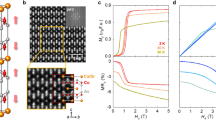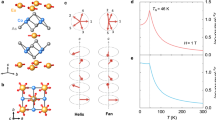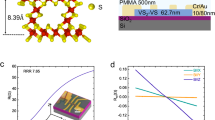Abstract
In the Kondo effect, a localized magnetic moment is screened by forming a correlated electron system with the surrounding conduction electrons of a non-magnetic host1. Spin S=1/2 Kondo systems have been investigated extensively in theory and experiments, but magnetic atoms often have a larger spin2. Larger spins are subject to the influence of magnetocrystalline anisotropy, which describes the dependence of the magnetic moment’s energy on the orientation of the spin relative to its surrounding atomic environment3,4. Here we demonstrate the decisive role of magnetic anisotropy in the physics of Kondo screening. A scanning tunnelling microscope is used to simultaneously determine the magnitude of the spin, the magnetic anisotropy and the Kondo properties of individual magnetic atoms on a surface. We find that a Kondo resonance emerges for large-spin atoms only when the magnetic anisotropy creates degenerate ground-state levels that are connected by the spin flip of a screening electron. The magnetic anisotropy also determines how the Kondo resonance evolves in a magnetic field: the resonance peak splits at rates that are strongly direction dependent. These rates are well described by the energies of the underlying unscreened spin states.
This is a preview of subscription content, access via your institution
Access options
Subscribe to this journal
Receive 12 print issues and online access
$259.00 per year
only $21.58 per issue
Buy this article
- Purchase on SpringerLink
- Instant access to full article PDF
Prices may be subject to local taxes which are calculated during checkout




Similar content being viewed by others
References
Hewson, A. C. The Kondo Problem to Heavy Fermions (Cambridge Univ. Press, Cambridge, 1997).
Owen, J., Browne, M. E., Arp, V. & Kip, A. F. Electron-spin resonance and magnetic-susceptibility measurements on dilute alloys of Mn in Cu, Ag and Mg. J. Phys. Chem. Solids 2, 85 (1957).
Gambardella, P. et al. Giant magnetic anisotropy of single cobalt atoms and nanoparticles. Science 300, 1130–1133 (2003).
Gatteschi, D., Sessoli, R. & Villain, J. Molecular Nanomagnets (Oxford Univ. Press, Oxford, 2006).
Kondo, J. Resistance minimum in dilute magnetic alloys. Prog. Theor. Phys. 32, 37–49 (1964).
Madhavan, V., Chen, W., Jamneala, T., Crommie, M. F. & Wingreen, N. S. Tunneling into a single magnetic atom: Spectroscopic evidence of the Kondo resonance. Science 280, 567–569 (1998).
Li, J., Schneider, W.-D., Berndt, R. & Delley, B. Kondo scattering observed at a single magnetic impurity. Phys. Rev. Lett. 80, 2893–2896 (1998).
Park, J. et al. Coulomb blockade and the Kondo effect in single-atom transistors. Nature 417, 722–725 (2002).
Liang, W., Shores, M. P., Bockrath, M., Long, J. R. & Park, H. Kondo resonance in a single-molecule transistor. Nature 417, 725–729 (2002).
Wahl, P. et al. Kondo temperature of magnetic impurities at surfaces. Phys. Rev. Lett. 93, 176603 (2004).
Heinrich, A. J., Gupta, J. A., Lutz, C. P. & Eigler, D. M. Single-atom spin-flip spectroscopy. Science 306, 466–469 (2004).
Leibsle, F. M., Dhesi, S. S., Barrett, S. D. & Robinson, A. W. STM observations of Cu(100)-c(2×2)N surfaces: Evidence for attractive interactions and an incommensurate c(2×2) structure. Surf. Sci. 317, 309–320 (1994).
Goldhaber-Gordon, D. et al. Kondo effect in a single-electron transistor. Nature 391, 156–159 (1998).
Cronenwett, S. M., Oosterkamp, T. H. & Kouwenhoven, L. P. A tunable Kondo effect in quantum dots. Science 281, 540–544 (1998).
Zhao, A. et al. Controlling the Kondo effect of an adsorbed magnetic ion through its chemical bonding. Science 309, 1542–1544 (2005).
Wahl, P. et al. Kondo effect of molecular complexes at surfaces: Ligand control of the local spin coupling. Phys. Rev. Lett. 95, 166601 (2005).
Nagaoka, K., Jamneala, T., Grobis, M. & Crommie, M. F. Temperature dependence of a single Kondo impurity. Phys. Rev. Lett. 88, 077205 (2002).
Shen, L. Y. L. & Rowell, J. M. Zero-bias tunneling anomalies—temperature, voltage, and magnetic field dependence. Phys. Rev. 165, 566–577 (1968).
Kogan, A. et al. Measurements of Kondo and spin splitting in single-electron transistors. Phys. Rev. Lett. 93, 166602 (2004).
Hirjibehedin, C. F. et al. Large magnetic anisotropy of a single atomic spin embedded in a surface molecular network. Science 317, 1199–1203 (2007).
Choi, T., Ruggiero, C. D. & Gupta, J. A. Incommensurability and atomic structure of c(2×2)N/Cu(100): A scanning tunneling microscopy study. Phys. Rev. B 78, 035430 (2008).
Appelbaum, J. A. Exchange model of zero-bias tunneling anomalies. Phys. Rev. 154, 633–643 (1967).
Costi, T. A. Kondo effect in a magnetic field and the magnetoresistivity of Kondo alloys. Phys. Rev. Lett. 85, 1504–1507 (2000).
Moore, J. E. & Wen, X.-G. Anomalous magnetic splitting of the Kondo resonance. Phys. Rev. Lett. 85, 1722–1725 (2000).
Lorente, N. Mode excitation induced by the scanning tunnelling microscope. Appl. Phys. A 78, 799–806 (2004).
Grobis, M., Rau, I. G., Potok, R. M. & Goldhaber-Gordon, D. in Handbook of Magnetism and Advanced Magnetic Materials (eds Kronmüller, H. & Parkin, S.) (Wiley, New York, 2007).
Schlottmann, P. Effects of crystal fields on the ground state of a Ce atom. Phys. Rev. B 30, 1454–1457 (1984).
Újsághy, O., Zawadowski, A. & Gyorffy, B. L. Spin–orbit-induced magnetic anisotropy for impurities in metallic samples of reduced dimensions: Finite size dependence in the Kondo effect. Phys. Rev. Lett. 76, 2378–2381 (1996).
Romeike, C., Wegewijs, M. R., Hofstetter, W. & Schoeller, H. Quantum-tunneling-induced Kondo effect in single molecular magnets. Phys. Rev. Lett. 96, 196601 (2006).
Acknowledgements
We thank M. F. Crommie, D. M. Eigler, A. C. Hewson, B. A. Jones, J. E. Moore and J. M. van Ruitenbeek for discussions and B. J. Melior for technical assistance. A.F.O. acknowledges support from the Leiden University Fund; M.T. from the Swiss National Science Foundation; K.v.B. from the German Science Foundation (DFG Forschungsstipendium); S.L. from the Alexander von Humboldt Foundation; C.F.H. from the Engineering and Physical Sciences Research Council (EPSRC) Science and Innovation Award and M.T., C.P.L. and A.J.H. from the Office of Naval Research. H.B. acknowledges EPFL for supporting his sabbatical stay with IBM.
Author information
Authors and Affiliations
Corresponding author
Rights and permissions
About this article
Cite this article
Otte, A., Ternes, M., von Bergmann, K. et al. The role of magnetic anisotropy in the Kondo effect. Nature Phys 4, 847–850 (2008). https://doi.org/10.1038/nphys1072
Received:
Accepted:
Published:
Issue date:
DOI: https://doi.org/10.1038/nphys1072
This article is cited by
-
Evidence for spinarons in Co adatoms
Nature Physics (2024)
-
Universal scaling of tunable Yu-Shiba-Rusinov states across the quantum phase transition
Communications Physics (2023)
-
Continuous manipulation of magnetic anisotropy in a van der Waals ferromagnet via electrical gating
Nature Electronics (2022)
-
Two-impurity Kondo effect in potassium-doped single-layer p-sexiphenyl films
Science China Physics, Mechanics & Astronomy (2022)
-
Trends in the hyperfine interactions of magnetic adatoms on thin insulating layers
npj Computational Materials (2021)



